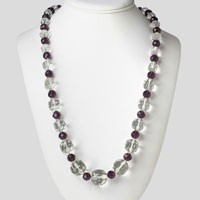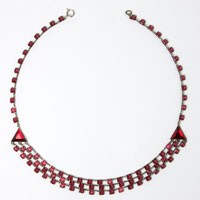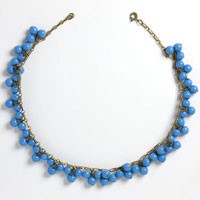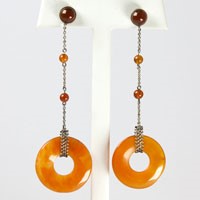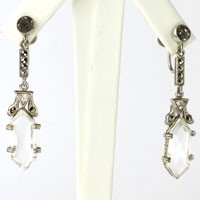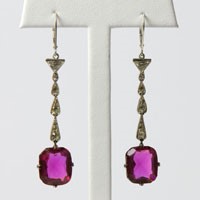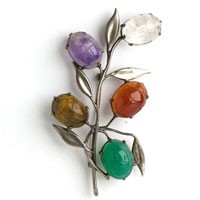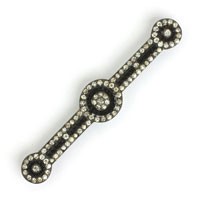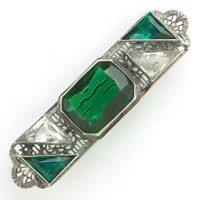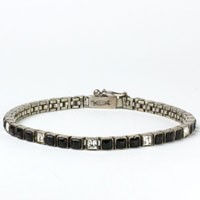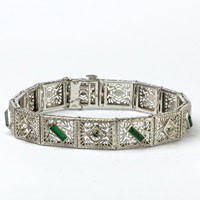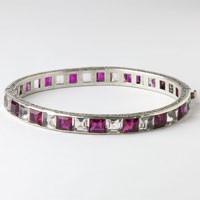The Art Deco Story: Costume Jewelry in the 1920s
Barbara Schwartz, www.trufauxjewels.com
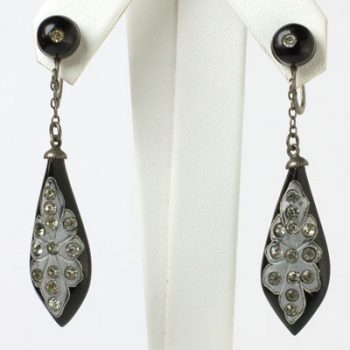
Black Bakelite & Diamanté Art Deco Dangle Earrings at TruFauxJewels
A symbol of the glamour and luxury that prevailed in the 1920s, Art Deco is the decorative style that reached its peak between the two world wars. Characterized by geometric shapes, bold colors, and stylized exotic motifs, it influenced every form of design: architecture, the decorative arts, the fine arts, film, photography, and fashion. And, of course, Art Deco jewelry.
The name Art Deco, coined in the 1960s, was derived from the Exposition des Arts Décoratifs et Industriels Modernes in Paris in 1925. This international world’s fair, originally scheduled for 1914 but postponed because of World War I, was intended as a showcase for the new modern style in the decorative and applied arts.
Because style is a reaction to/reflection of time and place, let’s look at the influences on the Art Deco style and their effects on fashion and jewelry in the 1920s.
Art Deco Jewelry Influences
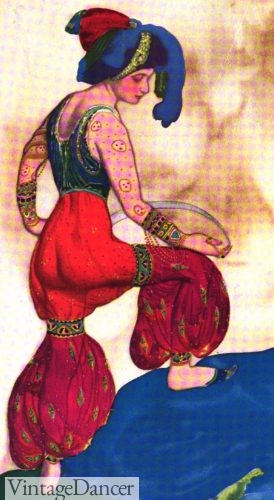 By the first decade of the 20th century, artists were rejecting the intricate curvilinear patterns of sinuous asymmetrical lines in muted colors that characterized Art Nouveau. Its motifs included flowers, insects, and profiles of women. Think of Tiffany glass, Alphonse Mucha paintings, and the Eiffel Tower, as examples.
By the first decade of the 20th century, artists were rejecting the intricate curvilinear patterns of sinuous asymmetrical lines in muted colors that characterized Art Nouveau. Its motifs included flowers, insects, and profiles of women. Think of Tiffany glass, Alphonse Mucha paintings, and the Eiffel Tower, as examples.
Avant-garde art movements, such as Cubism (a school of abstract art pioneered by Pablo Picasso and Georges Braque), were emerging throughout Europe. In 1907, Picasso painted Les Demoiselles d’Avignon, a portrait of five women. It abandoned perspective in favor of a flat, two-dimensional plane and incorporated African mask-like features on two of the faces.
Starting in 1909, Léon Bakst incorporated the avant-garde with Oriental and primitive motifs in the exotic and vibrantly-colored stage sets and costumes he designed for the Ballets Russes. Sergei Diaghilev’s production of Schéhérazade took Paris audiences by storm the following year.
The bold color combinations and profuse patterns not only dazzled audiences dressed in the pale, delicate, and lacy fashion of the Edwardian era – “le style ballets russes” captured the imagination of Parisian couturiers and interior designers. This color plate of a Bakst illustration was published by the Metropolitan Ballet Company (New York) in a 1916 souvenir program to promote the Russian Ballet’s American tour that year.
The influence of Oriental, Middle Eastern, and Egyptian art on design was augmented by Howard Carter’s discovery of King Tutankhamun’s tomb in 1922. It launched a fascination with all things Egyptian (known as Egyptomania). Motifs such as scarabs, pharaohs, lotus blossoms, and pyramids, as well as colors – turquoise and lapis – made their way into all areas of the arts. Art Deco jewelry was no exception.
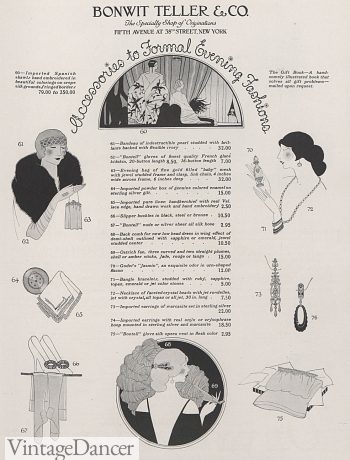
1923 Art Deco accessories
1920s Fashion: The Flapper
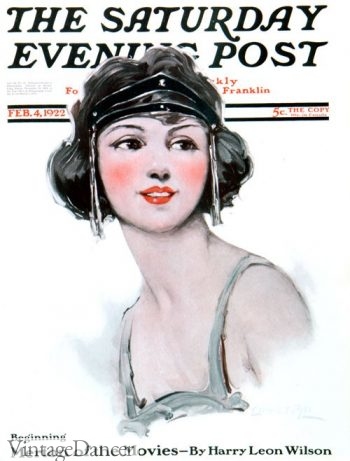
1922 Saturday Evening Post: The Flapper
Although La Garçonne, the fashion silhouette associated with this period, began in 1922, it didn’t really become widespread until the middle of the decade. Taken from the title of the 1922 French novel by Victor Margueritte, the name translates to The Bachelor Girl or The Flapper. Here is an artist’s depiction from the cover of the February 4, 1922 issue of The Saturday Evening Post.
This tubular, androgynous look featured dresses in bright colors and bold patterns, dropped or invisible waistlines, and hemlines that rose from ankle-length in 1924 to knee-length by the following year; hemlines remained there until the end of the decade.
The fashionable silhouette emphasized the slim, youthful body: square shoulders, flattened chest, narrow hips, and long legs. Women whose figures didn’t conform to the look relied on corsets to achieve the desired effect. A 1923 ad in Vogue stated: “‘Being slim may be a matter of pounds, but looking slim is a matter of where those pounds are placed.’ Gossard Corsets and Brassieres offer an easy way to keep the figure youthful”.
The flapper embodied the free spirit of the 1920s. Because she wore her hair short, a new style of hat – the French cloche – came into fashion. It fit tightly to the head and flared around the face. The brim was either turned up or angled down toward the face.
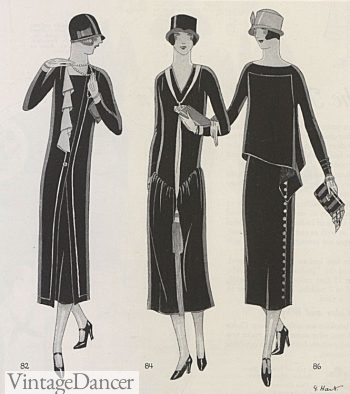
1924 Vogue fashion – daytime dresses
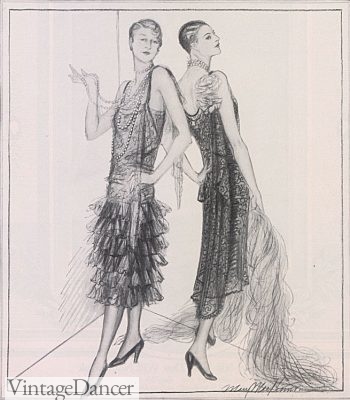
1925 Vogue Flapper Fashion
The ad from Bonwit Teller (a high-end clothing store) shown above is from the August 15, 1924 issue of Vogue. With the caption “Misses’ Advance Fall Silk Frocks” are three daytime dresses of that mode. The “coat-frock” on the left is made of “ottoman silk faille in black, navy blue or tile red, with contrasting jabot and pipings”; the middle, a “replica of a Patou frock … in black crepe-back satin, with ribbon tie and tassel in contrasting colors”; and the one on the right, “in Mongole crepe silk trimmed with ciré braid [in] black, brown or navy blue”.
Illustration on the right, the “Lace Evening Gowns” advertised by Bonwit Teller in the April 15, 1925 issue of Vogue are replicas of Chanel models. The one with ruffled tiers was made in black, blush pink, absinthe green, and cocoa; the other was available in black over black or pineapple over blush.
Both ads reflect the practice of French couturiers who sold their designs to select American retailers for reproduction.
Read more: The Flapper, who was she? History of Flappers in the 1920s
Shop Art Deco dresses and evening gowns in the 20s and 30s style.
The Flapper’s Art Deco Jewelry
In previous decades, women, other than the wealthiest, had a few good pieces, such as a strand of pearls, that they wore on special occasions. Now women in every income level were choosing jeweled accessories for each ensemble in the same way they chose shoes, handbags, and hats. By the 1920s, costume jewelry had come into its own as a desirable – even necessary – accessory. A 1922 article in Women’s Wear Daily reported:
“More and more importance is being given to costume jewelry each day, and department stores and avenue shops feature it in their windows and store cases in a lavish manner. These small articles that are depended on so very much of late for dress decoration are now considered important enough to be given entire windows for their display, and with the advent of the latest novelties from Paris, the avenue shops especially have been featuring all this class of merchandise.”
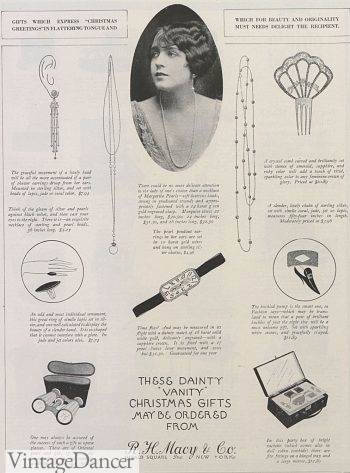
1922 Art Deco earrings, necklace, watch, hair clip
White metal (pot metal, silver, nickel, or chrome) or brass, clear crystal stones and beads (to imitate rock crystal), and richly-colored glass stones and beads (to imitate precious gemstones) were important components in most jewelry produced in this decade. Shimmering stones (pastes and marcasites) were used alone or to accent or contrast the others. Early plastics – Bakelite, Galalith, Celluloid – allowed designers to experiment and achieve styles that didn’t imitate precious jewelry and also produce an almost limitless range of colors.
To complement the elongated look of mid-1920s dresses and the dance craze, dangling, dazzling Art Deco jewelry that moved with the body and called attention to the wearer was key. Long strands of beads and faux pearls were worn in the usual way, draped down the back of an evening dress or across bare shoulders, or wound around the wrist to look like multiple bracelets. Other fashionable necklace styles included chokers, lariats, sautoirs (long strands of beads or pearls, ending in a tassel), and fringe necklaces. Here are some examples, which were all made in the 1920s (these are for sale in the TruFauxJewels shop).
- Amethyst & Crystal Bead 35” Long Necklace
- Ruby Chicklet Festoon Necklace
- Blue Bead Fringe Necklace
With shorter hair in style, women’s ears required adornment. A September 15, 1921 Vogue article reported: “Pendant earrings are returning to fashion … Frenchwomen and Englishwomen have both adopted, or rather re-adopted, these ornaments”. Here are some examples of 1920s Art Deco earrings.
- Carnelian Ring & Sterling German Earrings
- Crystal & Marcasite Dangling Czech Earrings
- Ruby, Diamanté & Sterling Earrings
Another type of essential 1920s jewel was the brooch, which decorated cloche hats and jacket lapels. Brooches were also worn on shoulders, applied to belts, and placed at the hip. Here are some examples of Art Deco brooches made in the 1920s.
- Scarab & Sterling Brooch by Walter Lampl
- Onyx, Diamanté & Sterling Bar Brooch by Fishel, Nessler
- Emerald, Crystal & Filigree Brooch by Ostby & Barton
Bracelets were an important accessory, especially for outfits with bare arms. Styles included flexible bracelets (today known as line or tennis bracelets) set with clear and colored glass stones, pierced (or filigree) bracelets, and bangles. An August 23, 1922 article in Women’s Wear Daily reported that women in Paris were wearing clusters of bracelets: “Word comes from Paris that the smart women there are wearing as many as 19 bracelets on one arm. These are all of the very thin type, however, and when the wider bands are used it is seldom that more than two are worn on the same arm.” Here are some examples of 1920s Art Deco bracelets.
- Onyx, Diamanté & Sterling Line Bracelet by Fishel, Nessler
- Emerald, Diamanté & Sterling Filigree Bracelet
- Ruby, Crystal & Sterling Bangle by H. Payton
The End of the Roar
The flapper, luxury, and good times that characterized the Roaring ‘20s came to a sudden end on October 29, 1929, when the stock market crashed in the U.S. It launched the Great Depression that spread around the world. But that’s another story.
For more 1920s Art Deco jewelry: necklaces, bracelets, earrings and brooches browse the jewelry at TruFauxJewels
*******************************************************
Barbara Schwartz is a costume jewelry expert and founder of TruFaux Jewels, an online boutique of beautiful and unusual pieces made in Europe and North America in the 1920s, 1930s, 1940s, and 1950s. Through her blog, social media, and private coaching sessions, Barbara helps women create their unique, personal styles by accessorizing contemporary fashion with vintage costume jewelry. A respected jewelry historian, she has lectured on fashion and jewelry history for the Association of Image Consultants International, at two conventions of Costume Jewelry Collectors International (CJCI), and as part of the Jewelry History Series at The Original Miami Antique Show. Her articles have been published on the CICI website, on the Kovels website, and in ADORNMENT: The Magazine of Jewelry & Related Arts
Shop Art Deo Jewelry
Debbie Sessions has been teaching fashion history and helping people dress for vintage themed events since 2009. She has turned a hobby into VintageDancer.com with hundreds of well researched articles and hand picked links to vintage inspired clothing online. She aims to make dressing accurately (or not) an affordable option for all. Oh, and she dances too.
